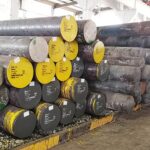D7 Tool Steel
D7 tool steel is a high-carbon, high-chromium air-hardening tool steel that exhibits exceptional wear resistance. The high carbon and vanadium contents result in numerous, hard vanadium carbide particles in the steel. These carbides exhibit a hardness that is equivalent to approximately 80 to 85 Rockwell C.
We can provide more services:
1、Hardening and tempering
2、Vacuum heat treatment
3、Polished bright surface
4、Milling bright surface
5、CNC machine
6、Deep drilling
7、Cut into small pieces
8、Make it closer to the mold
Welcome to inquiry price from drawing
Cutting:
Precision cutting to standard dimensions
Custom cutting according to client specifications
Surface Grinding/Polishing:
Thickness tolerance: -0 to +0.1mm
Flatness: 0.01/100mm
Surface roughness: Ra ≤1.6 or Rz ≤6.3
The following are the list of applications of D7 tool steels:
- Brick mold liners
- Powder compaction tooling
- Shot blasting equipment liners
- Flattening rolls
- Powder compaction tooling
- Tools for ceramic extrusion and molding.
Designations:
ASTM A681-US
FED QQ-T-570-US
SAE J437-US
SAE J438-US
UNS T30407-US
AISI D7 Tool Steel-US
Chemical composition(mass fraction)(wt.%) of the D7
| C(%) | Si(%) | Mn(%) | P(%) | S(%) | Cr(%) | Mo(%) | V(%) |
| 2.15~2.50 | 0.10~0.60 | 0.10~0.60 | ≤0.030 | ≤0.030 | 11.5~13.5 | 0.70~1.20 | 3.80~4.40 |
Smelting Option
1 EAF: Electric Arc Furnace
2 EAF+LF+VD: Refined-smelting and vacuum degassing
3 EAF+ESR: Electro Slag Remelting
4 EAF+PESR: protective atmosphere Electro Slag Remelting
5 VIM+PESR: Vacuum induction melting
Forming Option
1 Hot rolling process
2 Hot Forging: Electro-hydraulic; High-speed-hydraulic; Oil-hydraulic; Precision-forging
Heat-treatment Option
1 +A: Annealed (full/soft/spheroidizing)
2 +N: Normalized
3 +NT: Normalized and tempered
4 +QT: Quenched and tempered (water/oil)
Suface Option
1 Black Surface
2 Grounded: Bright but rough ; Not precision
3 Machining for plate: Bright and precision; Little turning scar
4 Peeled/Turned: Bright and precision; Little turning scar
5 Polished: Very Bright and precision size; Not turning scar
Other Services
1 Cutting: Small pieces
2 CNC Machine: Produce as your drawing
3 Package: Bare/Nylon/Canvas/Wooden
4 Payment:T/T, L/C, O/A(request credit)
5 Transport:FOB/CFR/CIF/DDU/DDP (train/ship/Air)
MECHANICAL PROPERTIES
| Yield Rp0.2 (MPa) |
Tensile Rm (MPa) |
Impact KV/Ku (J) |
Elongation A (%) |
Reduction in cross section on fracture Z (%) |
As-Heat-Treated Condition | Brinell hardness (HBW) |
| 984 (≥) | 682 (≥) | 41 | 31 | 23 | Solution and Aging, Annealing, Ausaging, Q+T,etc | 322 |
Forging/Rolling:
Preheat to 1500° F and soak thoroughly. Then raise to 2050° F – 2125° F. Do not forge or roll below 1800° F, cool slowly from the forging or rolling temperature. Do not normalize.
Annealing:
Heat slowly to 1600° F – 1650° F, and hold for uniformity, furnace cool at a rate of 20° F per hour to 1000° F then air cool. Expect Brinell hardness 235 – 262.
Hardening:
Preheat to 1500° F and soak until uniformly heated and either transfer or raise furnace temperature to 1850° F – 1950° F, and hold 1 hour per inch of greatest thickness. Cool in still air.
Tempering:
Temper immediately after quenching, before part has cooled to below 150° F. Parts should be held a minimum of 2 hours per inch of greatest thickness. Double tempering is recommended. For maximum wear resistance temper at 300° F. The above tempering table may be used as a guide. However, since 1/2″ dia. specimens were used for this test, it may be found that heavier sections are several points lower.

